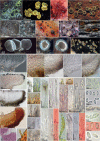A review of Hyphodiscaceae
- PMID: 37342153
- PMCID: PMC10277273
- DOI: 10.3114/sim.2022.103.03
A review of Hyphodiscaceae
Abstract
In a recently published classification scheme for Leotiomycetes, the new family Hyphodiscaceae was erected; unfortunately, this study was rife with phylogenetic misinterpretations and hampered by a poor understanding of this group of fungi. This manifested in the form of an undiagnostic familial description, an erroneous familial circumscription, and the redescription of the type species of an included genus as a new species in a different genus. The present work corrects these errors by incorporating new molecular data from this group into phylogenetic analyses and examining the morphological features of the included taxa. An emended description of Hyphodiscaceae is provided, notes and descriptions of the included genera are supplied, and keys to genera and species in Hyphodiscaceae are supplied. Microscypha cajaniensis is combined in Hyphodiscus, and Scolecolachnum nigricans is a taxonomic synonym of Fuscolachnum pteridis. Future work in this family should focus on increasing phylogenetic sampling outside of Eurasia and better characterising described species to help resolve outstanding issues. Citation: Quijada L, Baral HO, Johnston PR, Pärtel K, Mitchell JK, Hosoya T, Madrid H, Kosonen T, Helleman S, Rubio E, Stöckli E, Huhtinen S, Pfister DH (2022). A review of Hyphodiscaceae. Studies in Mycology 103: 59-85. doi: 10.3114/sim.2022.103.03.
Keywords: Helotiales; Leotiomycetes; keys; multi-gene phylogeny; new taxa; systematics; taxonomy.
© 2022 Westerdijk Fungal Biodiversity Institute.
Conflict of interest statement
The authors declare that there is no conflict of interest.
Figures










References
-
- Albertini von JB, von Schweinitz LD. (1805). Conspectus fungorum in Lusatiae superioris agro niskiensi crescentium e methodo Persooniana. Kummerian, Germany.
-
- Allescher A. (1898). Verzeichnis in Süd-Bayern beobachteter Pilze. IV. Abteilung: Hysteriaceae, Discomycetaceae et Tuberaceae. Bericht des Botanischen Vereins in Landshut 15: 1–138.
-
- Ayel A, van Vooren N. (2005). Catalogue des Ascomycètes récoltés dans la Loire -2e partie: Leotiomycetes, Orbiliomycetes et affines (discomycètes inoperculés). Bulletin mensuel de la Société linnéenne de Lyon 74: 5–32.
-
- Baral H-O. (1992). Vital versus herbarium taxonomy: morphological differences between living and dead cells of Ascomycetes, and their taxonomic implications. Mycotaxon 44: 333–390.
-
- Baral H-O. (1993). Beiträge zür Taxonomie der Discomyceten III (Calycellina, Cyathicula, Dasyscyphella, Hyphodiscus, Olla, Trichopeziza, Venturiocistella). Zeitschrift fûr Mykologie 59: 3–22.
LinkOut - more resources
Full Text Sources
Research Materials
